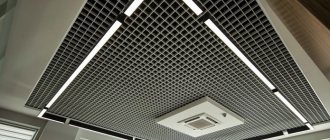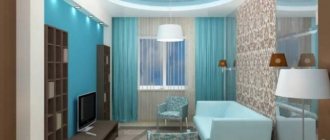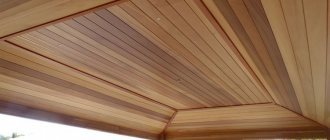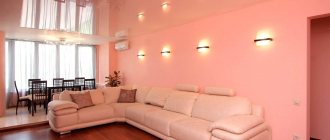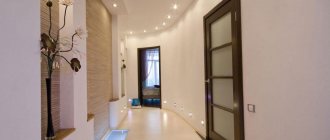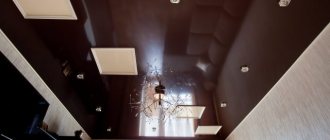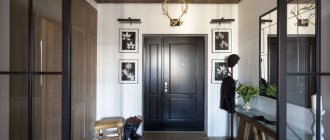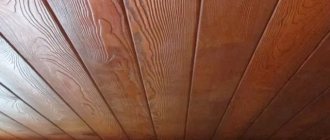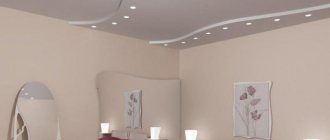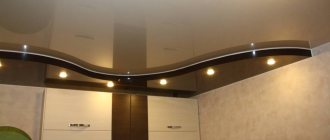Nowadays, few people remember that the Armstrong ceiling was originally developed as an inexpensive and easy-to-install ceiling covering for large shopping centers. But, thanks to its versatility and aesthetic appearance, Armstrong ceiling decoration is now installed in restaurants, offices and even some apartments. But what is the secret of such popularity?
Purpose and advantages of suspended ceiling
The main function of the Armstrong suspended ceiling is to hide various types of defects and irregularities underneath it. In addition, they are a good decoration. The panels have a beautiful appearance and design, so they will fit well into the interior of the room. The richness of colors and the ability to integrate lighting elements into them are all advantages of using pendant systems as decoration.
Armstrong suspended ceiling with built-in lighting
And due to the specifics of the installation, communication means can be hidden behind the ceiling tiles. This is a pretty good solution, since you don’t have to mask the wiring in baseboards or walls.
It is also worth mentioning the properties of ceiling panels. They are an excellent way to soundproof. Their installation will save you from noisy neighbors on the upper floors.
What are the slabs made of?
The company's factories are located throughout Europe, and in Europe they have long been striving to produce exclusively environmentally friendly products. Armstrong ceiling tiles are positioned as environmentally friendly because they are made partly from recycled products and partly from natural materials.
The tiles include:
- cellulose;
- mineral wool;
- starch;
- clay;
- perlite;
- water.
For the final aesthetic finishing, painting with water-soluble paint or covering with fabric is used.
Armstrong never uses asbestos in the manufacture of its products.
There are so-called soft and hard types of slabs, which differ in the percentage of mineral wool. “Soft” ones contain more mineral wool than “hard” ones, they are more porous and lighter, and absorb sounds better.
Soft and hard slabs in the interior
Armstrong suspended ceiling installation
The suspended ceiling is created from a multi-component frame on which the slabs themselves are installed. This design is very reliable and will last a long time.
The frame is created from a variety of metal profiles, longitudinal and transverse. It is attached to the ceiling using a fastening unit and a suspension, which consists of a hook and a rod.
Armstrong suspended ceiling installation
The most massive and strong elements of the metal profile stand on the sides of the structure, forming a rectangle. The remaining beams are placed on it in accordance with the future number of slabs. It consists of a load-bearing profile of 3700 mm, a perimental profile of 3000 mm (required if you need to install trimmed slabs), a longitudinal profile of 1200 mm and a transverse profile of 600 mm. As a result, this all forms a frame for the suspension system.
Installation of suspended ceiling Armstrong
Armstrong suspended ceiling panels are most often produced square, with dimensions of 600x600 mm. It is not always possible to fit exclusively equal slabs onto the entire ceiling. For this reason, they can be trimmed without compromising overall reliability.
Mineral fiber slabs are divided using a mounting knife or its analogues. Cutting them is quite easy. With hard materials things are more difficult. For example, to cut a glass ceiling tile, you will need a tool with a diamond base.
If necessary, suspended ceiling slabs can be trimmed
The design of the Armstrong suspension system itself is extremely simple. And its main advantage is considered to be the possibility of installation on a ceiling with defects. Various irregularities, chips, dilapidated paint - all this is not a hindrance to the suspension system. After all, its panels are not installed directly to the ceiling, but are attached to a pre-installed frame. And thanks to its reliability, the design will last for many years.
Preparing the base for installation
Installation of any decorative covering, including Armstrong-type suspended ceilings, requires preliminary preparation of the base:
- It is better to remove the old coating (paint, decorative plaster). Accidentally peeling off old whitewash or a piece of paint can damage the slab, leading to financial losses.
- Detected cracks are filled with putty to reduce heat loss and the growth and development of pathogenic microorganisms.
- Next, you should carefully examine the rough ceiling to identify possible leaks. Waterproofing is carried out for these areas.
- A wooden sheathing is installed around the perimeter of the ceiling, onto which fiber boards of thermal insulation are attached.
At the same stage, the wiring is removed and the ventilation system is installed. High-quality ventilation ensures sufficient air circulation, prevents the accumulation of condensation, and prevents the development of fungal colonies.
Fastening
The suspension system is built in using a suspension. For this purpose, there is a system of many fastening units that are located in the base ceiling, as well as hooks on the structure itself. The length of the pendant can be adjusted. Thanks to this, it will be possible to change the final height of the Armstrong suspended ceiling.
The suspension elements are attached to the supporting metal profiles of the frame. Their installation step, according to standards, is 1.2 meters. There is one more condition: the suspension units should not be located further than 45 cm from the walls. But this is not always feasible. For this reason, it is possible to arrange the suspension units along the length of the room according to the principle of chess pieces. As a result, they will move back and forth during installation.
Armstrong suspended ceiling mount
In some places on the longitudinal and transverse profile, additional fastening units are provided. They are used to support concentrated loads.
Characteristics
The Armstrong range of slabs is large: from economy class products to luxury ones. Naturally, their technical and operational characteristics are different. Here are the standard ones inherent to products in the mid-price segment:
- Armstrong tile size is standard: length - 60 or 120 cm; width - 60 cm thickness - 8-25 mm;
- weight - 2.5-8 kg/m2;
- moisture resistance - 70-100%;
- noise absorption - up to 35 dB;
- flammability class - NG (non-flammable);
- flammability - B0 (non-flammable);
- smoke formation - D0 (does not smoke);
- toxicity - T0 (not toxic at high temperatures);
- light reflection level - up to 85% (mirror surfaces - up to 99%);
- profile type - open and hidden.
Installation of suspended systems
The entire installation process can be divided into four main parts: preliminary calculation, preparation of the room, installation of the frame and assembly of the ceiling system itself. It is quite possible to cope with everything on your own, without resorting to the help of specialists. But the entire process of placing an Armstrong suspended ceiling will take a certain amount of time and require many special tools and skills.
Calculation
One of the first preliminary steps is to calculate the Armstrong suspended ceiling. In this case, measurement accuracy is very important. Small deviations towards the larger side are not critical; the material can always be trimmed. However, if the calculated dimensions turn out to be smaller than the actual ones, then the volume of the slabs will not be enough to occupy the entire space of the ceiling. In this case, installing a suspension system will lose any meaning.
Measurements must be taken at the wall joints themselves. The result should be length and width indicators. Next comes the calculations. It is necessary to calculate the required number of slabs, taking into account their size and shape. For example, a room has dimensions of 3x4 m. The width will require five slabs (5x0.6 m), and the length - six whole and one trimmed (6x0.6+0.4 m). Then it remains to find out their total number. For a ceiling with a length of 4 meters and a width of 3, you will need 35 whole slabs, 5 of which will have to be cut by 20 cm.
Armstrong suspended ceiling calculation
Along with the number of hanging panels, you should calculate the dimensions of the frame for their installation. It should contain the same number of metal profile cells as the calculated number of plates. For rooms with an aspect ratio of 3x4, per square meter of ceiling you will need: 80 cm of load-bearing and transverse profiles, 160 cm of longitudinal and 50 cm of perimental, as well as 0.6 units of suspension. In case of discrepancies in sizes, larger numbers than necessary should be taken into account.
Preparation of tools and premises
After all the calculations have been carried out, and the ceiling slabs and materials for the frame have been ordered, you can proceed to the second stage. Now you need to prepare all the necessary tools and clean the room. The room in which the Armstrong suspension system will be installed must be free. It is necessary to remove all furniture and other things that will interfere with installation. After all, during assembly, the frame will take up most of the floor.
List of required tools:
- Hammer. It will be used to make holes in the walls and ceiling for fastening units. Suitable for concrete or stone walls. If they are wooden, then you can use a drill or a powerful screwdriver to replace the hammer drill.
- Level. Used to determine the angle of inclination or evenness of a surface. The best option would be a laser level, it is more accurate. But the classic version, with an air bubble, is also suitable. It is recommended that this level exceed one meter in length.
- Phillips screwdriver. It will be needed for screwing in self-tapping screws during the assembly and installation of a frame made of metal profiles.
- Hammer. It will help when aligning metal profiles in a frame or fixing them in wooden walls.
- Construction pencil. With its help, you can make the necessary notches on the walls and ceiling.
- Roulette. Used for measuring room dimensions and when cutting slabs or metal profiles
- Pliers. You can use regular pliers to replace them.
Tools for installing Armstrong suspended ceilings
During the installation process, various connecting elements will also be needed: screws, dowels, nails, and so on. Additional tools may also be required. But above is a list of the seven most necessary ones.
Frame installation
After completing the preparatory stage, you can begin directly installing the frame into the ceiling. The main action should begin with the installation of the perimeter. To mark its height, according to construction standards, it is recommended to use a laser or classic level. Moreover, its length must exceed a meter. But level markings can be replaced in a non-standard way. It is possible to change the height of the perimeter the other way around. That is, first mark the floor level and mark vertical dimensions in the corners. And then beat off the outline with a chalked cord. But this method will require three people, but it is much faster.
Markings for installing the Armstrong ceiling
The next step is to cut the perimental profile to the required size. After that you can start attaching it to the walls. The self-tapping screws are screwed into pre-installed dowels. This method is suitable for concrete and brick walls. If the suspended ceiling is not planned to be particularly heavy, without a lot of concentrated loads, then it can be secured to wooden ceilings using nails. This will be faster, but the entire structure becomes difficult to disassemble.
Ceiling frame suspension units
After the necessary marks have been made on the ceiling along with the perforation of the holes, you can begin to prepare the 3700 mm load-bearing profile. It must be cut to the required size obtained at the calculation stage. Next on the floor it should be combined into strips of the required length. And then lay the structure within the perimeter.
Installation of support rails
When these actions are completed, you can move on to the next stage. Now the supporting profiles should be extended along their length and the required number of hanging elements should be placed on them. The installation step is 1.2 meters. For greater reliability, each supporting metal profile is aligned with the sag using a tightly stretched cord or rope.
Installation of cross bars
The final stage of installing the Armstrong ceiling frame is the installation of longitudinal and transverse profiles. But first you need to cut the elements to the required size. There are two installation schemes: parallel and cross. The first is easier to implement, but less reliable. Placing the second one in the frame will be a more difficult task. But the cross pattern of installation of longitudinal and transverse profiles provides greater reliability. For this reason, it is used for places with additional load, with insulation or where communications pass. In terms of material consumption, parallel and cross circuits are almost identical.
Ready-made suspended ceiling frame Armstrong
All stages of installation should be carried out as competently and efficiently as possible. Errors in the process can lead to unreliability of the suspension system and its rapid failure. In some situations, the frame can become dangerous for people in the room. After all, if he falls, injuries are possible.
After installation, all that remains is to connect the wiring and various communications where necessary. The location system should be thought out in advance. It will depend on the number of concentrated loads and built-in elements.
Installation of lamps
Assembly
After these steps, the frame is securely fixed to the base ceiling. Now you can move on to the final stage - the final assembly of the ceiling. First of all, you need to trim the panels. And then post them.
Panels or concentrated blocks should be placed at an angle behind the frame, and then installed in the profile cell. Now they will hold securely.
Installation of Armstrong ceiling panels
You should start by placing concentrated blocks in the cells of the frame, as well as connecting communication means to them. After placing them, you can move on to the lamps. They must also be connected to electrical wiring. The last elements will be the ceiling panels themselves.
If the slab is crooked in any way, for example, at an angle, then it should be leveled. It is very important not to put pressure on it from above, but rather push it from below in the lower corners. In this way, it will be possible to arrange the slabs among the cells of the frame as evenly as possible. Thanks to this, the suspended ceiling will look aesthetically beautiful.
The words of a famous foreman:
The entire installation of a suspended ceiling, from measurements to assembly, can be done independently. With the right approach, you won’t need the help of experts. Carefulness is important in this matter. Errors in calculations can lead to insufficient panel materials or metal profiles along with fasteners. And poor-quality installation and assembly will negatively affect the service life. However, complete adherence to construction instructions and standards will allow you to install the suspended ceiling as competently as possible.
Video description
How to install or replace a lamp in an Armstrong ceiling is shown in this video:
- Fastening spotlights and ceiling air conditioning.
They are also used in hanging systems. Why are holes made in the panels, taking into account the diameter of the lamp fittings? After installing the stove, lighting devices are connected to the electricity. Ventilation air intakes are also cut into. It is recommended to install air conditioning units in the most fortified areas.
Installing a ceiling air conditioner will require special knowledge, so it is recommended to choose installation companies that have specialists in climate systems Source airclimat.ru
- Panel installation.
The blind parts are put into place last. They need to be inserted diagonally into the cell and placed on the guides, then, lifting from below and unfolding, placed in the grooves.
Embedded elements
The structure of the frame of the Armstrong suspension system is such that it is possible to install not only ceiling tiles in it. Various equipment for the system are made in a square shape, with dimensions of 600x600 mm.
The most popular of the elements built into the ceiling are lamps. Raster panels are framed panels, inside of which there are several lamps. Ceiling lamp variations are also produced. They have a more standard look. This model consists of a panel with a socket, and the lampshade protects it.
Installing a lamp in an Armstrong ceiling
For a suspended kitchen ceiling, a built-in ventilation panel will be relevant. The advantage of its placement will be the fact that all communications and the drainage system can be hidden behind the panels. There are also air conditioning units for ceiling systems. In addition to the equipment variations presented above, there are many others.
Ceiling ventilation panel Armstrong
All built-in elements place additional load on the Armstrong suspended ceiling. For this reason, it is not recommended to install them on wooden walls to which the frame is secured with nails. For greater stability of the suspension system with equipment, additional fastenings are used. A pendant is placed on the remaining metal profiles, which is then attached to prepared units on the ceiling.
Construction details
An Armstrong ceiling is a collection of easily interconnected parts. Its advantage, such as modularity, makes it possible to obtain a ceiling system of various shapes and sizes.
The only thing that is not available is obtaining a ceiling of a nonlinear configuration. This limits the scope of use of Armstrong only to rectangular and square rooms.
Accommodation options
An important feature of the Armstrong suspension system is its block system. It is not necessary to place only a row of mineral fiber panels. You can add lamps, air conditioners, ventilation grilles and other equipment to it. This will increase the overall practicality of installing the hanging system.
Ventilation grille for suspended ceiling
Or you can add external beauty and design to it. There is already a lot of room for improvement. With ordinary panels, metal or mirror ones can be placed in the frame cells. This will not add functionality to the ceiling, but it will transform its appearance. There are special panels on which drawings are applied. They are made not only from metal and PVC, but also from glass. Such solutions will be more expensive in price, but will also look more interesting.
Mirror panels in the Armstrong ceiling
With the help of a variety of variations of panels on the Armstrong ceiling, you can create a whole ornament. And this will add color to the room in which it is located and make it more beautiful, as well as more unique. A look at such a ceiling will be pleasant for both the owners and guests of the house.
Pattern on the panels in the Armstrong ceiling
In what rooms is it recommended to install
Armstrong tiled ceiling can be used in almost any building. The scope of their application is determined by the properties of the panel material:
- in swimming pools, hospitals, baths, warehouses, terraces, laundries - moisture resistant;
- in restaurants, clinics, hotels, auditoriums and concert halls - acoustic;
- hygienic - for medical institutions, kindergartens, catering units, etc.
This type of finishing is also found in residential premises - most often in the bathroom, but it is also installed in the kitchen and balcony.
Photo gallery – Armstrong suspended ceiling
Varieties
Such systems are very similar in appearance, but this does not mean that all types of slabs will have the same characteristics. Basically, the differences relate specifically to the characteristics of the tiles, since the same frame base is used in all cases. There are the following types:
- "Economy class. These are the “Baikal”, “Tatra”, “Oasis” and “Cortega” slabs. They have good characteristics in terms of strength, service life, environmental friendliness and are not too expensive.
- Prima class. These are parts with high resistance to water. The price will be noticeably higher, but such elements can be used even in rooms with a humidity of 95 percent. They do not lose their shape and do not turn yellow.
- Soundproofing boards. This finishing option is intended for rooms that have problems with noise pollution. Such a ceiling will significantly reduce the level of extraneous noise entering the room.
- Bioguard series. These coatings are intended for installation in places where there are increased requirements for environmentally friendly finishing and hygiene. An ideal solution for medical or children's institutions.
- Designer series. The most expensive types of ceilings of this system. However, the high cost is justified by the exclusivity of the coatings and excellent appearance.
You can choose the appropriate type of slabs for any interior. However, to ensure ease of installation and increase the number of individual solutions, there are not only different types of panels, but also different options for the edges of such parts. Each variety allows you to give the assembled structure a certain appearance. There are three edge options:
- Microlook
- Tegular
- Board
Of these, the latter will be the most universal, since it does not in any way affect the pattern of the assembled surface. The first two, depending on the type, will allow you to assemble a structure with more or less pronounced boundaries between the fragments of the coating.
Texture Features
The slabs have the following choice of textures:
- with embossing;
- with perforation;
- general geometric pattern on the entire ceiling;
- additional decorative elements.
The plates come with embossing and perforation.
Perforated modules are well suited for different rooms. They look beautiful and are inexpensive, and this is often important when arranging medical, public and other buildings.
